はじめに
現在は機械学習の学習をやっている.
今回はニューラルネットワークのフレームワークであるKeras及びTensorFlowを触ってみることにする.
www.tensorflow.org
上記のチュートリアルを使用し,適宜コメントなどを追加して理解を深めていく.
実装
データの読み込み
#https://www.tensorflow.org/tutorials/keras/classification?hl=ja # に勉強のために適宜コメントを追加 # TensorFlow と tf.keras のインポート import tensorflow as tf from tensorflow import keras
# ヘルパーライブラリのインポート import numpy as np import matplotlib.pyplot as plt print(tf.__version__)
2.6.0
# Fashion-MNIST # ファッション写真のデータセットをロード fashion_mnist = keras.datasets.fashion_mnist (train_images, train_labels), (test_images, test_labels) = fashion_mnist.load_data()
データの可視化
# 訓練データは6万枚,テストデータは1万枚 print(train_images.shape) print(test_images.shape) # 1枚目の画像を表示 import matplotlib.pyplot as plt plt.figure() plt.imshow(train_images[0]) plt.colorbar() plt.grid(False) plt.show() # 黒が255,白が0,28×28の画像 # 一般的な画像は白が255なので逆
(60000, 28, 28)
(10000, 28, 28)
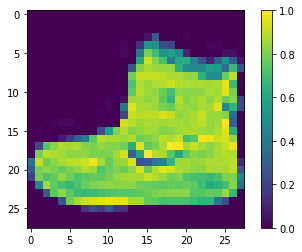
# ラベルは10種類 print(train_labels.shape) print(np.unique(train_labels)) # ラベルは[0 1 2 3 4 5 6 7 8 9]のようになっている # 手動でラベル名を設定しておく class_names = ['T-shirt/top', 'Trouser', 'Pullover', 'Dress', 'Coat', 'Sandal', 'Shirt', 'Sneaker', 'Bag', 'Ankle boot']
(60000,)
[0 1 2 3 4 5 6 7 8 9]
# データの正規化(0~1にする) train_images = train_images / 255.0 test_images = test_images / 255.0
# 訓練データの先頭25枚を表示 plt.figure(figsize=(10,10)) for i in range(25): # 5×5に並べて表示 # subplot(5,5,6)と指定すると,2行1列目部分にプロット plt.subplot(5,5,i+1) plt.xticks([]) plt.yticks([]) plt.grid(False) plt.imshow(train_images[i], cmap=plt.cm.binary) plt.xlabel(class_names[train_labels[i]]) plt.show()
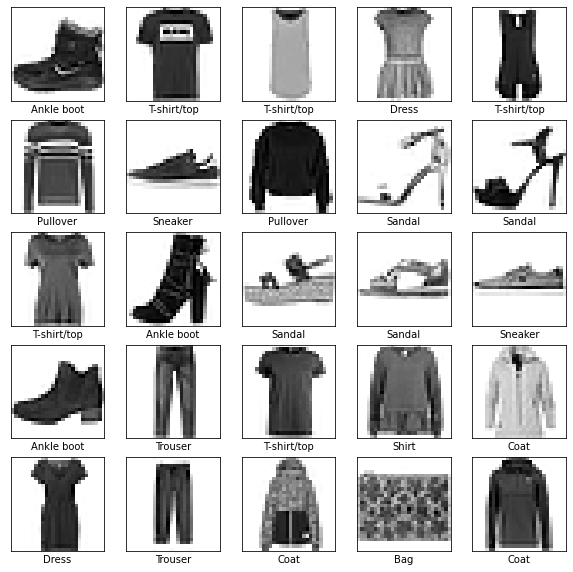
モデルの構築
# モデルの構築 model = keras.Sequential([ # 入力層 = 28×28の二次元配列を1次元(28*28=784)に平坦化する keras.layers.Flatten(input_shape=(28, 28)), # 出力が128個の中間層,活性化関数はReLU keras.layers.Dense(128, activation='relu'), # 出力が10個の出力層,活性化関数はsoftmax keras.layers.Dense(10, activation='softmax') ])
ポンチ絵を描いてみた.
おそらくこんな感じだと思われる.
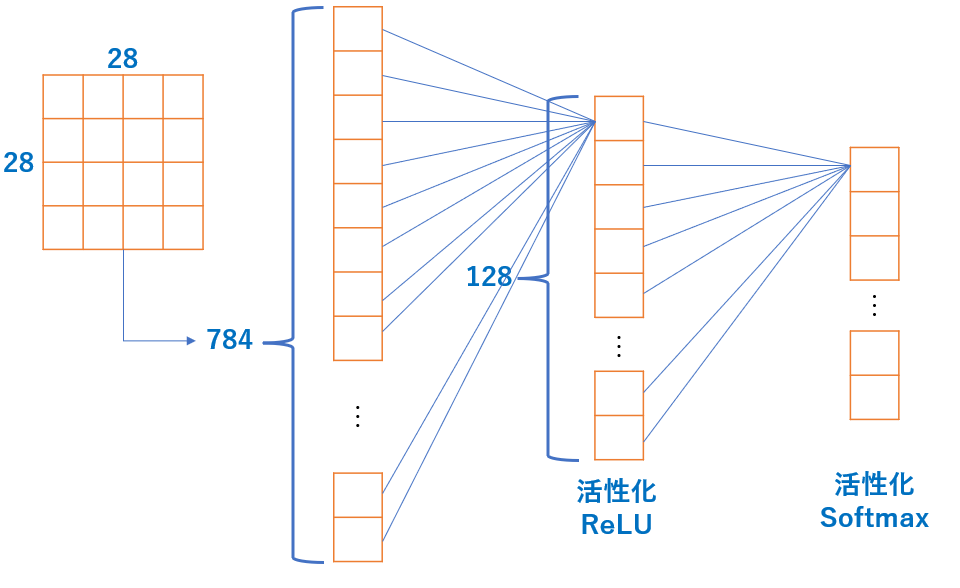
出力層の活性化関数にSoftmax関数を使うのは各出力の総和を1にするため.
各出力を確率として表せる.
例えば['T-shirt/top', 'Trouser', 'Pullover', ...] = [0.7, 0.1, 0.02, ...]という出力になったら,Tシャツの確率が70%であると言える.
# 最適化アルゴリズムはadam # 誤差関数はクロスエントロピー # 評価関数は正解率 model.compile(optimizer='adam', loss='sparse_categorical_crossentropy', metrics=['accuracy'])
最適化アルゴリズムは誤差関数が小さくなるようにネットワークの重みを更新していくアルゴリズム
局所最適解に陥らないように上手い事やる
誤差関数はモデルが出力した結果と正解との差
3値以上の分類にはクロスエントロピーが用いられる
評価関数はモデルの性能(予測精度)を定量的に表すための関数
今回は分類問題の基本的な評価指標であるところのaccuracy(正解率)を使用
keras.io
学習
model.fit(train_images, train_labels, epochs=5)
Epoch 1/5
1875/1875 [==============================] - 2s 742us/step - loss: 0.4980 - accuracy: 0.8238
Epoch 2/5
1875/1875 [==============================] - 1s 698us/step - loss: 0.3736 - accuracy: 0.8659
Epoch 3/5
1875/1875 [==============================] - 1s 731us/step - loss: 0.3346 - accuracy: 0.8796
Epoch 4/5
1875/1875 [==============================] - 1s 699us/step - loss: 0.3123 - accuracy: 0.8866
Epoch 5/5
1875/1875 [==============================] - 1s 698us/step - loss: 0.2928 - accuracy: 0.8919
1エポックあたり1秒くらいで学習が終わった.
test_loss, test_acc = model.evaluate(test_images, test_labels, verbose=2) print('\nTest accuracy:', test_acc)
313/313 - 0s - loss: 0.3604 - accuracy: 0.8720
Test accuracy: 0.871999979019165
引数のverboseって何じゃろと検索したところ
www.tensorflow.org
verbose 0 or 1. Verbosity mode. 0 = silent, 1 = progress bar.
とあって0 or 1を取る値とのこと.
何で2を入れてるねんと思ってverbose=1にしたところ以下のようになった.
313/313 [==============================] - 0s 471us/step - loss: 0.3604 - accuracy: 0.8720
Test accuracy: 0.871999979019165
verbose=1だとプログレスバー及びステップごとの計算時間も表示された.
欲しいのは正解率などの指標なので,verbose=2がこの場合は良いっぽい.
予測
# 予測する predictions = model.predict(test_images) # 予測結果の1個目を表示 predictions[0]
array([9.9368699e-06, 1.2327422e-07, 1.6504961e-07, 9.8506057e-09,
5.9519666e-06, 3.3276793e-02, 2.7124054e-06, 2.4480930e-01,
3.0131891e-05, 7.2186488e-01], dtype=float32)
pred_0 = np.argmax(predictions[0]) print(f'予測:{class_names[pred_0]}') print(f'正解:{class_names[test_labels[0]]}') # 1枚目の画像を表示 import matplotlib.pyplot as plt plt.figure() plt.imshow(test_images[0]) plt.colorbar() plt.grid(False) plt.show()
予測:Ankle boot
正解:Ankle boot
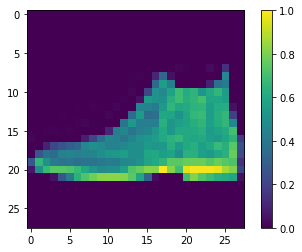
となり,1個目は正解した.
predictions[0].sum() # = 1.0
なお,結果の合計値を計算してみると確かに1.0になっており,Softmax関数による確率表現となっている.
def plot_image(i, predictions_array, true_label, img): predictions_array, true_label, img = predictions_array[i], true_label[i], img[i] plt.grid(False) plt.xticks([]) plt.yticks([]) plt.imshow(img, cmap=plt.cm.binary) predicted_label = np.argmax(predictions_array) if predicted_label == true_label: color = 'blue' else: color = 'red' plt.xlabel("{} {:2.0f}% ({})".format(class_names[predicted_label], 100*np.max(predictions_array), class_names[true_label]), color=color) def plot_value_array(i, predictions_array, true_label): predictions_array, true_label = predictions_array[i], true_label[i] plt.grid(False) plt.xticks([]) plt.yticks([]) thisplot = plt.bar(range(10), predictions_array, color="#777777") plt.ylim([0, 1]) predicted_label = np.argmax(predictions_array) thisplot[predicted_label].set_color('red') thisplot[true_label].set_color('blue')
結果を表示する関数を実装.
i = 0 plt.figure(figsize=(6,3)) plt.subplot(1,2,1) plot_image(i, predictions, test_labels, test_images) plt.subplot(1,2,2) plot_value_array(i, predictions, test_labels) plt.show()
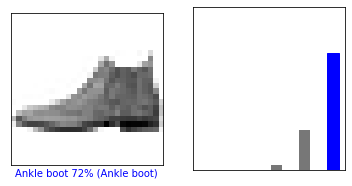
i = 12 plt.figure(figsize=(6,3)) plt.subplot(1,2,1) plot_image(i, predictions, test_labels, test_images) plt.subplot(1,2,2) plot_value_array(i, predictions, test_labels) plt.show()
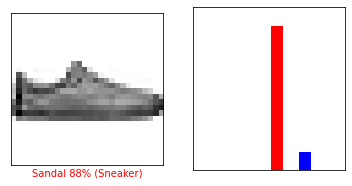
88%の確率でサンダルです!っつって間違ってしまっている.
# X個のテスト画像,予測されたラベル,正解ラベルを表示します. # 正しい予測は青で,間違った予測は赤で表示しています. num_rows = 5 num_cols = 3 num_images = num_rows*num_cols plt.figure(figsize=(2*2*num_cols, 2*num_rows)) for i in range(num_images): plt.subplot(num_rows, 2*num_cols, 2*i+1) plot_image(i, predictions, test_labels, test_images) plt.subplot(num_rows, 2*num_cols, 2*i+2) plot_value_array(i, predictions, test_labels) plt.show()
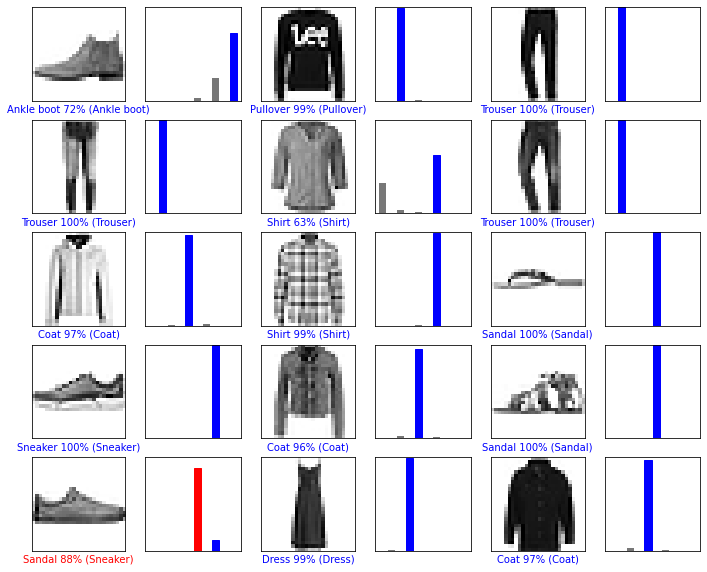
まとめ
今回はKeras及びTensorFlowのチュートリアルを進めた.
中間層が1つしか無いが,正解率87%という良い結果を得られた.
Kerasのおかげで大分実装が簡単になっている.
層とか評価関数を引数として指定するだけだからね.
ニューラルネットワークの実装はKerasがやってくれるため,
私の方ではデータや結果の可視化をしっかりとやっていく必要があると感じた.
また,スニーカーの画像を自信満々(88%)にサンダルと言って間違うということもあり,そこはせめて迷って欲しかった.
(サンダル60%,スニーカー40%の確率で判定した,とか)

